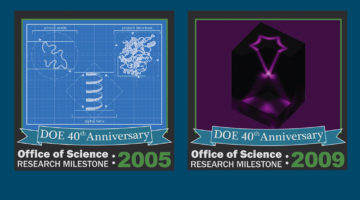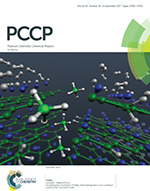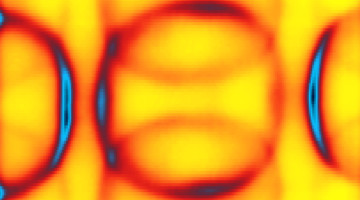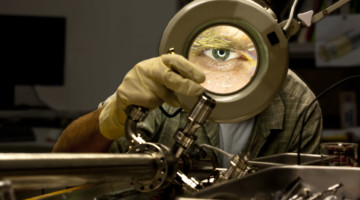To celebrate DOE’s 40th anniversary (October 1, 2017), the Office of Science (SC) collected 40 scientific milestones from the previous 40 years, each one supported by SC. The ALS played a key role in two of the milestones: 2005 (ribosome) and 2009 (topological materials). Read more »
All News & Updates
Electrical Switching of Magnetic Vortex Circulation
Photoemission electron microscopy (PEEM) experiments have demonstrated that the circulation direction of a magnetic vortex can be switched by the application of an electric field, opening the door to digital devices with more streamlined system designs, improved performance, and greater energy efficiency. Read more »![]()
![]()
New Study on Graphene-Wrapped Nanocrystals Makes Inroads Toward Next-Gen Fuel Cells
A powdery mix of metal nanocrystals wrapped in single-layer sheets of carbon atoms shows promise for safely storing hydrogen for use with fuel cells for passenger vehicles and other uses. Now, a new study provides insight into the atomic details of the crystals’ ultrathin coating and how it serves as selective shielding while enhancing their performance in hydrogen storage. Read more »
Elucidating the mechanism of MgB2 initial hydrogenation via a combined experimental–theoretical study
Magnesium borohydride Mg(BH4)2 is a promising solid-state hydrogen-storage material, releasing 14.9 wt% hydrogen upon conversion to MgB2. Although several dehydrogenation pathways have been proposed, the hydrogenation process is less well understood. This study elucidates the key atomistic mechanisms associated with the initial stages of hydrogen uptake within MgB2. Read more »
The Mystery of the Lightweight Electrons
Copper oxides are important for superconductivity applications but are difficult to understand due to complex charge, spin, and orbital interactions. Now, studies at the ALS have found such a system in which observations of effective electron mass are at odds with state-of-the-art electronic-structure calculations. Read more »
Amorphous calcium carbonate particles form coral skeletons
Skeletons of Stylophora pistillata corals form by the attachment of amorphous calcium carbonate precursor particles, formed within the coral tissue, to the coral skeleton surface. This mechanism is faster than the precipitation of ions from solution and may render the corals less susceptible to ocean acidification than previously assumed. Read more »
Users Highlight Light Source Impacts in Capitol Hill Briefing
A panel of light source users participated in a briefing for Capitol Hill staff highlighting the critical role DOE x-ray light source user facilities play in advancing new technologies, the challenges posed by increasing international competition from Europe and Asia, and how next-generation upgrades to these facilities will open new scientific frontiers. Read more »
Explore the ALS in 3D and Virtual Reality
Ever wondered what’s under the ALS dome and inside the accelerator tunnels powering our light source? Now you can explore the ALS from your computer or don a VR headset (even something as simple as a Google Cardboard) and find out! Read more »
An Intern’s Vision Becomes (Virtual) Reality
For ALS Summer Intern Sam Schickler, the most exciting part about the ALS isn’t its famous dome, the particle accelerator it houses, or the x-ray experiments themselves–it’s the data. It’s why the rising 11th grader jumped at the chance to spend the summer at the ALS developing virtual reality (VR) experiences of ALS data and the ALS facility. Read more »
Enter the ALS “Science as Art” Competition: September 18 Deadline
Do you have an artistic eye? Enter your scientific images or photographs that show the aesthetic side of ALS x-ray data and instrumentation in the ALS “Science as Art” competition. The competition will be judged at the upcoming User Meeting, but anyone can enter. Read more »
- « Previous Page
- 1
- …
- 103
- 104
- 105
- 106
- 107
- …
- 139
- Next Page »









